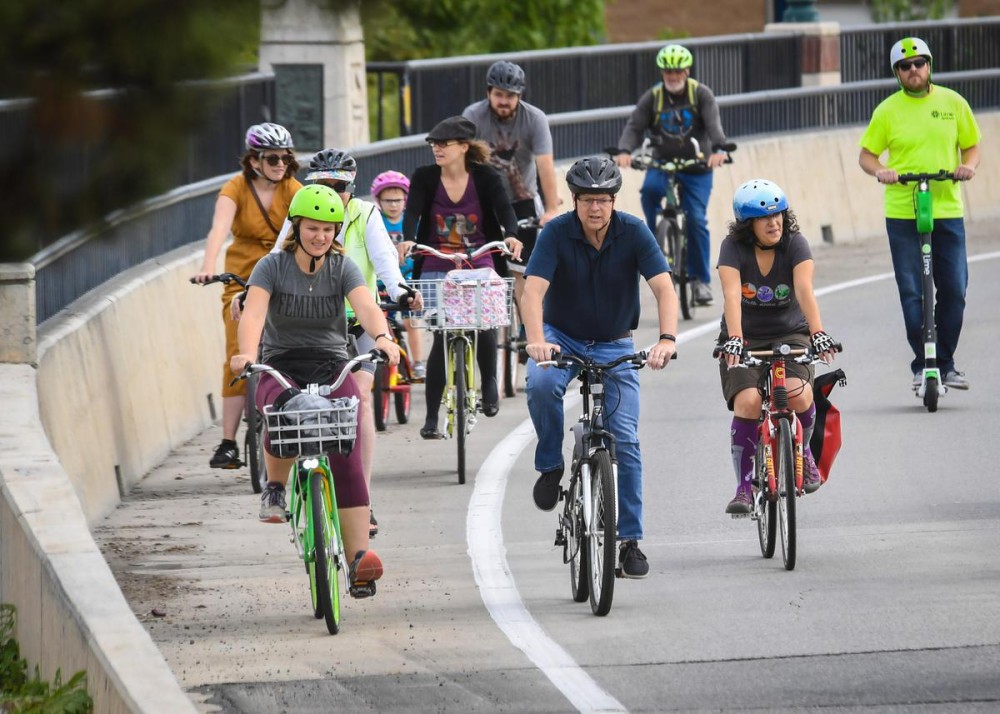Temporary bike lane to connect university pedestrian bridge with greenway project
Tuesday, September 10, 2019

(as reported in the Spokesman-Review by Nick Deshais)
A temporary protected bicycle lane will be installed on Spokane Falls Boulevard in the University District, connecting Spokane’s new bicycle and pedestrian bridge to the incomplete Cincinnati Greenway.
Beginning Sept. 28, the two-way cycle track will run along the north side of the road for about one-third of a mile, from the intersection of Spokane Falls and Sherman Street to Cincinnati Street, which is undergoing renovation as a bicycle corridor. A line of orange traffic bollards will separate bikes from cars.
Spokane City Councilman Breean Beggs, who is behind the temporary bikeway, said the pilot project has two goals. First, the “pop-up” bike lane will help determine whether the road should have a permanent bike lane separated from traffic by a curb or wall. Second, the pilot project is intended to demonstrate the use of temporary infrastructure; Beggs said similar projects could be replicated as a cost-saving measure to see if infrastructure is necessary before major dollars are spent.
“You can do these all over the city,” he said.
A recent study found that cities with protected bike facilities had roads that were “not only safer for bicyclists but for all road users.” The study was published in the June edition of the Journal of Transport and Health and was based on 13 years of data collected from 12 large U.S. cities.
The idea for the bike lane came from a May brainstorming session that Beggs organized, which brought together about 50 bicycling advocates, planners, engineers and representatives from local universities to discuss how to promote and increase bicycling in the city. The top two principles that came from that daylong meeting focused on increasing connectivity and safety of bikeways in the city.
“We have this amazing piece of infrastructure that creates all kinds of opportunities,” Beggs said of the $15 million University District Gateway Bridge. “But we had no particular plan to connect it” with other bike infrastructure, notably the greenway, a type of nonarterial road where cars go slow enough to make walkers and cyclists feel safe and comfortable.
When complete next month, the $567,000 greenway project will connect Gonzaga University and the University District with the 5-mile Addison-Standard bike corridor, a north-south bikeway that terminates in the Shiloh Hills neighborhood north of the Division Y.
The city also is exploring what type of bikeway to build at the bridge’s south landing, where McKinstry and Avista are at work on the Catalyst Building, the future home for Eastern Washington University’s Spokane campus of 1,000 computer science, electrical engineering and visual communication design students.
Kara Odegard, coordinator of the council’s sustainability action subcommittee, said the pop-up bike lane was an example of the city “doing as much as we can with as little funding as we can.” The cost of the temporary project is coming from the subcommittee’s budget and will pay for the rental of temporary barriers and other materials. Beggs said the cost would be “a few thousand” dollars.
Similar low-cost, quick-build projects – occasionally dubbed “tactical urbansim” – were the subject of a recent study published by the National Academies of Science. The study focused on transit-related projects like temporary dedicated bus lanes, and found they reduced travel time, increased safety and boosted ridership, all for a fraction of what it would cost to make permanent changes. About three-quarters of the projects in the study – including those in San Francisco, Denver, Miami and Toronto – are planned to be made permanent.
The report did contain a bit of bad news for Spokane’s project, which will last for only a week.
“Like any roadway project, traffic takes time to adjust,” the report reads. “In fact, six months is the recommended duration to fully assess the project’s impact following an adjustment period.”
The pop-up bikeway won’t be the first of its kind in Spokane, though it is the first official one. In 2017, an unofficial bike lane was spray-painted on Riverside Avenue after the city removed a bike lane there. The city painted over the lane within weeks.
Beggs said he hopes to hear a “positive response” during the one-week trial, especially from Gonzaga, EWU and the Spokane Transit Authority, which has to move two bus stops temporarily to accommodate the bike lane. He said he believes the occurrence of the annual art event, Terrain, on Oct. 3 and 4 in the University District, will drive more people to use the protected bike lane.
Regardless of response, Beggs said temporary protected bike lanes could be tested as a safe route to schools in every Spokane neighborhood.
“Maybe a school principal will see the pop-up and say, ‘Let’s give it a shot,’ ” he said.